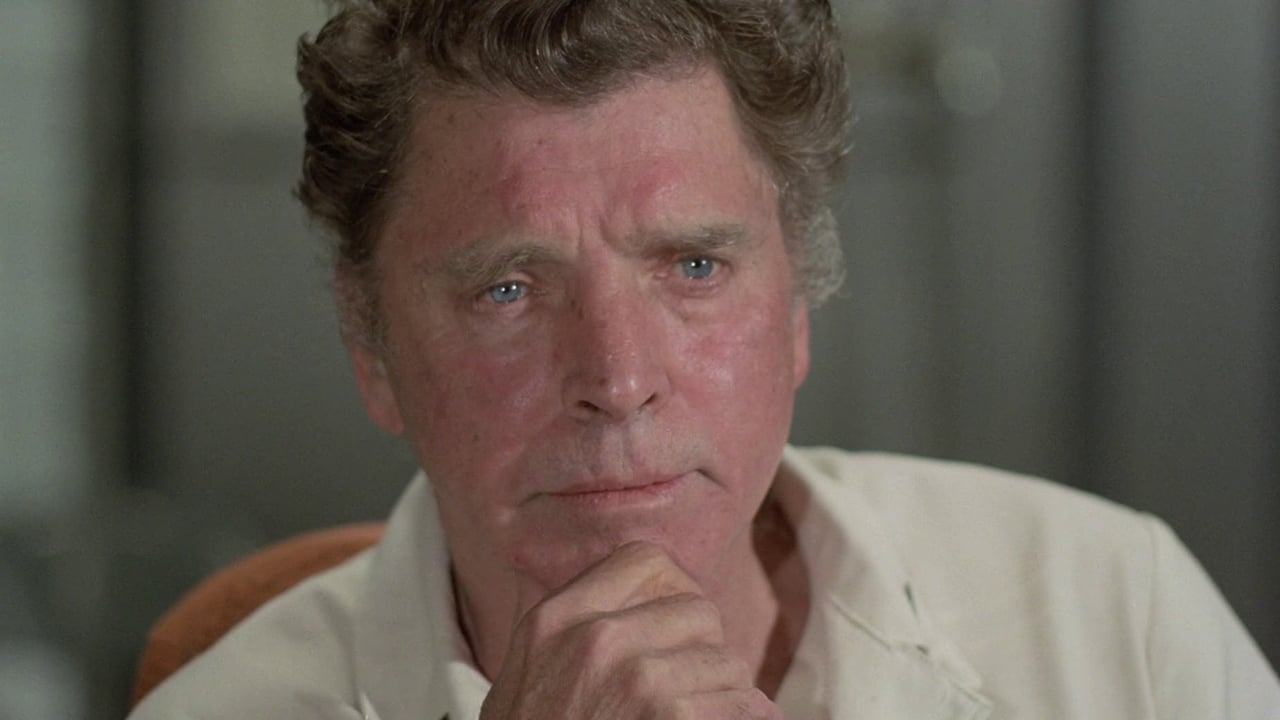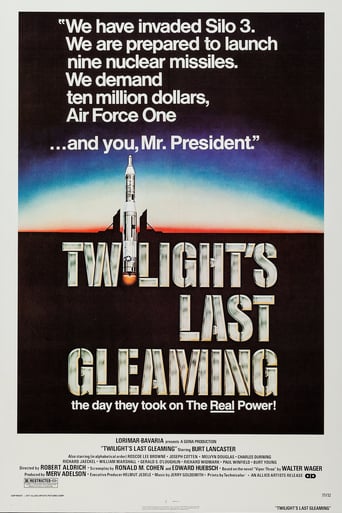



Sadly Over-hyped
It really made me laugh, but for some moments I was tearing up because I could relate so much.
View MoreIt’s sentimental, ridiculously long and only occasionally funny
View MoreThrough painfully honest and emotional moments, the movie becomes irresistibly relatable
View More1977 was a year of some high profile bombs which later achieved some cult status such as Cross of Iron, Sorcerer and Twilight's Last Gleaming. This partially came about from the competition from a certain film called Star Wars which offered a more optimistic and hopeful cinematic experience. As someone who has mixed feeling on New Hollywood, these movies don't deserve to be ignored the way they are and are some of the best hidden gems of the 1970's. Likewise the trashy, conspiracy theory concept of Twilight's Last Gleaming would be the ire of many high brow critics but it's the high concept which makes Twilight's Last Gleaming irresistible and helps the viewer to look past the implausibility of the premise. This is a film which trades it's logic for emotion and is aware of its own implausibility ("How in the hell does some joker walk into a top secret installation and get control of the most sophisticated weapons system in the world?"). As a layman it feels believable within the context of the movie but it's always fun to ask, could it happen in real life?Twilight's Last Gleaming features an ironic use of 'My Country Tis of Thee' during the opening and closing credits; it's not exactly a happy movie. Oddly however Jerry Goldsmith's score sounds like something from an action/adventure blockbuster and is even John Williams like at time. The action takes place over a single day in what can be described as Dog Day Afternoon like scenario in a missile silo for a film which you could mistaken as being based on a stage play with its handful of sets and lengthy scenes. On my first viewing I wasn't convinced the running time was justified but watching it again I was hooked. Twilight's Last Gleaming takes is set in the future year of November 16th, 1981 although it's not stated why it's set on this particular date.Burt Lancaster was still getting some great roles into the 1970's. He still had his mojo and now with a beat up face to boot. As one of the character's in the film puts it, "with that rhetoric he could be elected governor in ten states". Lancaster's role of General Lawrence Dell draws parallels to his role of General Scott in the political thriller Seven Days In May; a megalomaniac going to extremes in order to fulfil his agenda despite the risks to the United States and the world as a whole. He may be trying to provide a catharsis to the pain and anger of Vietnam veterans but at what cost? Lancaster and co star Paul Winfred have an enjoyable chemistry between them and provide comic relief with their back and forth. It's interesting seeing Lancaster sparring off with actors much younger than him as well as dropping some F-bombs. On top of that there is something surreal about watching Burt Lancaster drinking a can of Coca-Cola. Product placements for Coca-Cola appear at several points throughout the film with Coke vending machines in clear sight; I guess they have to answer to The Coca-Cola Company.Twilight's Last Gleaming consists of veteran actors talking some serious stuff. The discussions in the Oval Office scene are alot to take in on one viewing ("Ralph! Are you comparing Vietnam to Hitler?!" - It always goes back to Hitler). The movie is full of entertaining one liners - "It's like Star Trek all over again", "Come on this isn't Disneyland" and my favourite, "There are no midgets in the United States Air Force". The oldest among this cast is Melvyn Douglas, the prime example of an actor who got better with age as clearly evident here; full of powerful subdue comments and monologues ("The beginning of the end of mankind, in graphic black and white").The film's extensive use of split screen works remarkable well and does not feel like a gimmick creating a unique viewing experience; the split screen here is clearly not an afterthought. The entire sequence in which missiles are about to be launched is presented entirely in split screen with events being monitored in three different locations in order to heighten the tension. The scene itself is one scary sequence with the pandemonium and the sight of the missiles rising (the model of the silo exterior is shown on screen just briefly enough not to notice they are models). The President himself describes it best - "The opening of the doors of hell".The President in Twilight's Last Gleaming played by Charles Durning is not an idealistic representation of a president nor is he massively charming and ultimately a bit drab. However we do get to see his human side during a scene in which he talks to his General alone and admits to being scared out of his mind. At the beginning of the film there is a scene in which the President has a conversation with a character played by Roscoe Lee Brown. It doesn't have purpose in the plot but does set the tone of the White House scenes and foreshadows the rest of the movie ("If I grant Zabat sanctuary, I give approval to every dissident with a cause and a gun").The ending of Twilight's Last Gleaming all comes down to the question of whether or not society can deal with the truth? With widespread distrust in the government starting with the assassination of JFK and not getting any better with the Watergate scandal, would the President's cabinet reveal the movie's purported truth on the Vietnam War to the American public like he ordered before being shot down in an attempt to take down the two men holding him hostage. However was his death even an accident or did they intend to let him be shot down in order to keep the truth hidden; it does seem odd that no medical aid is given to him after being shot. The ending is left ambiguous and the viewer is left to think about it.
View MoreDespite the thick-ear dialogue, lack-lustre performances from most of the cast, (Charles Durning being the notable exception), and the frankly ridiculous premiss of a renegade general taking over a nuclear missile silo and holding the US government to ransom, Aldrich's dip into the Cold War paranoia genre is surprisingly good, working both as a highly suspenseful thriller, (Aldrich makes great use of split screens), and as a reasonably serious picture on American foreign policy. It's also funny enough to work as political satire and I'm not sure that Aldrich took it all that seriously. It may not be in the same class as either "Seven Days in May" or "Fail Safe" and television dramas such as "The West Wing" and "House of Cards" are much closer to the mark on what goes on in the Oval Office than anything here but it's also far from negligible and if it's hardly Aldrich's best film it's still well worth seeing.
View MoreI agree with the general drift of the comments logged to this date. I would add only this: as I watched John McCain expunge the Bush administration from the recent history of the United States this film sprang to mind. To say more would spoil the climax of the film. Burt Lancaster gave master classes in film acting in many of his movies, and in none more so that in Twilight. The other actors were superb. I had the strange experience of seeing the film on network television in 1977, and as the closing credits began to roll, my phone rang. It was a person I had not seen or heard from in over a year, her first words being: "Did you see THAT?" So much for Twilight and telepathy.
View MoreThis movie was a waste of some very talented people. I liked all of the actors but the people who wrote this movie knew nothing of ICBM security or launch protocols. Even when I was 16 it seemed to be full of holes.First off, the missileers cannot launch missiles without a series of codes. These codes must be sent to the launch team before they can arm anything. NORAD controls that. If a missile crew got the wild idea to do an independent launch, the computers and arming systems would not work until the code was called in. The Air Force does not have a bunch of armored vehicles ready to roll in (including the surplus USMC Ontose recoiless rifle carrier they painted blue and used).The snipers had stock M-16s with screw-on scopes. Cheezy.Even if you can overlook all of that by saying procedures had changed and gotten lax and we had decided to remove the external consent requirement to launch there are 2 BIG issues that were missed.One: all the Air Force had to do was open fire on the missiles and they would have burned and probably blown up on the pads (without setting off the nukes, they have a VERY specific initiation process that is NOT triggered by heat). It is all NASA can do to keep rockets and missiles from blowing up on a perfect launch. In case you did not know, a missile is 90% pressurized fuel tank. poke a hole in it and it'll never fly, at least not far. Small arms fire could do it, but artillery or anti-tank missiles would be best.Two: There is no way the president is ever going to be handed over as a hostage.All of that is just technical trivia. The idea that America would enter a war and stay in it until we had lost 50,000 men just to show the evil commies we were serious is beyond absurd. To buy that requires just plain gullibility. Anyone with the slightest knowledge of American History knows that the war in Viet Nam lasted over 3 presidential administrations, yet the movie makes us believe that one decided to keep us in the until no less than 50,000 Americans died and so it became policy.Nothing about this forgettable film is timeless or relevant. It is a piece of junk that preyed on cold war fears of nuclear missiles and government mistrust (which were very much in the public consciousness in post Viet Nam, Post Watergate America). If you want to see Burt Lancaster and Charles Durning together in a much netter movie, see Tough Guys.
View More